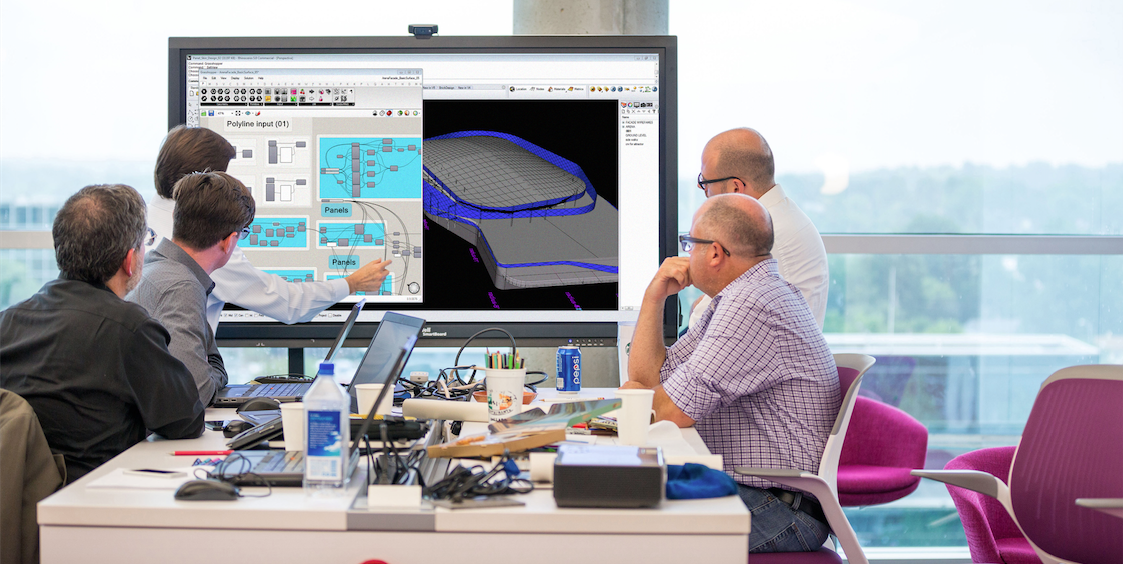Should architects learn to code? This question was posed by computational design consultant Nathan Miller, Founder and Managing Director of Proving Ground, in a recent blog post about the rise of data-driven design. Miller’s answer: “Well, maybe.”
While Miller and other computation experts don’t expect every design professional to become Mark Zuckerberg in “The Social Network” (“Don’t interrupt him. He’s plugged in!”), there is no denying the growing importance of the utilization of data and computation in the design process. HDR, NBBJ, Populous, Thornton Tomasetti, and Woods Bagot are among the firms that are investing in talent and training to advance their CD capabilities.
ALSO SEE
6 ways smart AEC firms are using computational design methods
During his four-plus years as a CD consultant, Miller has assisted these firms and others in developing a business roadmap for breaking into data-driven design. We asked him for tips and advice on getting started. He offered the following:
1. Define the business value of computational design. Computational design is an open-ended methodology, not a class of software tools with predefined features for a specific uses.The value of computation is greatly dependent on how well an AEC organization positions the new skill sets, tools, and workflows relative to the business.
“I’m often confronted with questions akin to some variation of, ‘Can Grasshopper or Dynamo do X,’” says Miller. “The reality is quite the opposite: Computational design is about the process of creating solutions. The question is better framed as, ‘What can we create that will help us better solve X design problem?’”
It could involve developing an algorithm that can greatly increase the speed of solving repetitive design problems, or creating a tool for a project or market that can provide an advantage for a firm looking to differentiate its services in a competitive marketplace.
For CD to be meaningful to a business at scale means determining the desired outcomes, coupled with a strategic framework for developing a team capable of creating high-impact solutions, says Miller.
2. Pilot computational design services in the areas where your firm takes the most risks. AEC firms tend to be risk adverse when it comes to changing process. Factor in increasingly tighter deadlines and shrinking fees, and it can make computational design a hard sell to firm leaders.
‘Design organizations should be looking for do-it-yourself creative thinkers that have a knack for making digital tools.’
—Nathan Miller, Proving Ground
Miller says a number of his AEC clients have had success winning over firm leaders and scaling up CD operations by piloting these tools and processes in the areas of the practice where the firm traditionally takes more risks, namely project pursuits, RFPs, and design competitions.
“When you know you’re going up against strong competition and you want to take some calculated risks, those become very good entry points for computational design,” says Miller. “By going the computation route with an RFP or competition submission, it may allow the firm to explore a problem a little differently, or capture that process and fold it into the overall narrative.”
Win a few projects and light bulbs will start going off throughout the practice.
3. Hire for passion of building design, not for coding prowess. It’s much tougher to teach a game designer or software engineer about the building design process than it is to teach an architect or engineer basic coding skills. Many firms, however, are looking to the tech markets—computer science, simulation, software engineering, game development—to build their CD teams.
“Where the real moment with computational design concepts comes to bear is when you engage the opposite—give a couple of designers who are really passionate about buildings the skills to be able to code,” says Miller.
He has advised AEC clients to modify their job requisitions for entry-level designers coming out of school to include skill sets like experience with computational design software. “If you’re a firm looking to grow your CD capability, you need to change the demographic of the people applying for the position,” says Miller.
4. Invest in people, not software. Computational design software is a drop in the bucket compared to the six- and seven-figure investments firms have had to make in CAD and BIM software tools. Grasshopper is a free plug-in. Dynamo is open source. The tools are essentially free. The real investment is in finding the right people and then advancing their computation capabilities.
“As with most things that drive success in service organizations, people should be the focus of business investment for executing a successful computational design strategy,” says Miller. “Design organizations should be looking for do-it-yourself creative thinkers that have a knack for making digital tools.”
5. Apply the 70/20/10 ratio when assembling your computation-enabled design team. While no two firms are the same, Miller has discovered a sweet spot for the makeup of computation-enabled design teams: the 70/20/10 ratio. Seventy percent should have enough working knowledge to be able to “pull the levers” on pre-made computational tools; 20% should have a high comfort level with building simple tools and modifying complex project algorithms; 10% should have an advanced skill set in creating sophisticated tools and solutions.
Having a team with a range of skill sets, says Miller, will encourage broader participation, skill growth, and engagement across the organization.
Project leaders and firm management need to be active participants in the implementation process. “They don’t need to know the nuts and bolts of the tools, but they do need to understand how the project process is changing so they can give the team a platform to deliver valuable design solutions,” says Miller.
For more on computational design, read Proving Ground’s blog.
Related Stories
BAS and Security | May 26, 2022
Can your intelligent building outsmart hackers?
ESD's security services studio leader Coleman Wolf offers tips, advice, and lessons for protecting real estate assets from cyberattacks.
Architects | Apr 26, 2022
Low-tech skills architects need to keep in a high-tech world
As architects continue to lean into learning and mastering the latest technologies, let us not forget the foundational, fundamental skills that are still expected by clients. RS&H National Design Director Philip Robbie explains.
AEC Tech | Apr 19, 2022
VDC maturity and the key to driving better, more predictable outcomes
While more stakeholders across the AEC value chain embrace the concept of virtual design and construction, what is driving the vastly different results that organizations achieve? The answer lies within an assessment of VDC maturity.
AEC Tech | Apr 13, 2022
Morphosis designs EV charging station for automaker Genesis
LA-based design and architecture firm Morphosis has partnered with automotive luxury brand Genesis to bring their signature brand and styling, attention-to-detail, and seamless customer experience to the design of Electric Vehicle Charging (EVC) Stations.
AEC Tech | Apr 13, 2022
A robot automates elevator installation
Schindler—which manufactures and installs elevators, escalators, and moving walkways—has created a robot called R.I.S.E. (robotic installation system for elevators) to help install lifts in high-rise buildings.
Hotel Facilities | Apr 12, 2022
A virtual hotel to open in the metaverse
A brand of affordable luxury hotels that launched in 2008, citizenM has announced it will purchase a digital land site in The Sandbox, a virtual game world owned by Animoca Brands.
Modular Building | Mar 31, 2022
Rick Murdock’s dream multifamily housing factory
Modular housing leader Rick Murdock had a vision: Why not use robotic systems to automate the production of affordable modular housing? Now that vision is a reality.
AEC Tech Innovation | Mar 9, 2022
Meet Emerge: WSP USA's new AEC tech incubator
Pooja Jain, WSP’s VP-Strategic Innovation, discusses the pilot programs her firm’s new incubator, Emerge, has initiated with four tech startup companies. Jain speaks with BD+C's John Caulfield about the four AEC tech firms to join Cohort 1 of the firm’s incubator.
AEC Tech | Feb 11, 2022
Trimble Dimensions+ 2022 Call for Speakers Now Open
Trimble has opened its Call for Speakers for the Trimble Dimensions+ 2022 User Conference, which will be held November 7-9 at the Venetian Resort in Las Vegas.
Coronavirus | Jan 20, 2022
Advances and challenges in improving indoor air quality in commercial buildings
Michael Dreidger, CEO of IAQ tech startup Airsset speaks with BD+C's John Caulfield about how building owners and property managers can improve their buildings' air quality.














